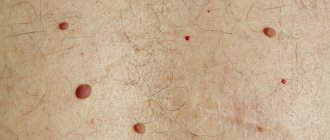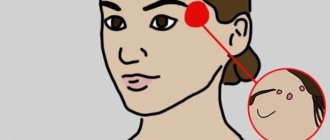Types of complications after traumatization of moles
Traumatization of moles, as doctors note, is the most unpleasant thing about the existence of these neoplasms.
Moreover, injuries not only cause immediate discomfort to patients, but also lead to the development of a number of complications.
Among them:
- Bleeding
Usually they are local in nature and do not pose a serious threat to the body.
They often occur, for example, if a woman shaved off a mole under her arm during a standard hygiene procedure.
May be significant in duration.
Hydrogen peroxide, which is soaked in a tampon and then applied to the problem area, can help cope with bleeding.
- Partial separation
A variant of traumatization in which a convex skin defect remains hanging on a strip of fabric, ceasing to fully adhere to the skin.
Patients note severe pain, may suffer from bleeding, and complain of other unpleasant sensations.
- Full break
The same option when a mole under the arm was removed, but the defect does not heal.
Patients also complain of pain and bleeding.
- Infection
When frequently traumatized, a mole becomes an excellent entry point for various infections to enter the body.
In this case, it can become inflamed, fester, and sometimes even become necrotic.
Causes of hanging moles
Hanging moles often appear on areas of the body with thin skin that are subject to regular friction. As a result of constant exposure, an accumulation of pigmentation cells occurs and the formation of growths of 2-5 mm. In some cases, the length of hanging moles can reach several centimeters.
Factors that contribute to the appearance of hanging moles:
- Hormonal changes in the body - puberty, pregnancy or menopause.
- Various skin lesions.
- Excessive exposure to ultrasound radiation - with prolonged exposure to the sun, the body begins to produce an excess amount of melanin, which is responsible for the appearance of moles on the body.
- Stress, nervous tension - when the psycho-emotional background is disturbed, a strong release of adrenaline occurs in the body, which affects the metabolic processes in skin cells.
Hereditary predisposition also plays an important role in the appearance of hanging moles. If parents suffer from a large number of nevi, there is a high probability that the problem will be inherited and passed on to the child.
Most often, hanging moles form in people with fair skin who spend a lot of time under the sun or in a solarium.
A mole is changing: when should you be concerned?
Nevi in the armpit area may differ from each other in color, shape, and size.
However, normally they are all united by one important feature - they are all benign.
Doctors have identified a number of signs by which one can suspect the onset of malignant degeneration and begin to sound the alarm.
It is recommended to be concerned if the mole:
- began to quickly increase in size, occupying an increasingly larger surface of the skin
- has changed its structure or consistency, becoming, for example, too hard or too soft, although it previously had the opposite symptoms
- changed the color to a darker one compared to the original (if a mole under the armpit turns black, this is always a serious reason to seek medical help)
- an itching sensation and discomfort appeared in the problem area (benign neoplasms are not capable of causing such sensations, which is important to remember)
- bleeding has increased (a healthy benign nevus almost never bleeds, but a malignant formation often responds by releasing blood to any irritation)
- pronounced inflammatory changes appeared in the tissues adjacent to the formation, which are difficult to ignore
If a patient discovers any of these signs, this is a reason to consult a doctor for help without delay.
After all, such changes signal malignant degeneration.
In the long term, this can be fatal for the patient's body.
The meaning of a left-sided mole under the armpit of a man
- For a man, any marks on the left side of the body are considered extremely undesirable, as they indicate negativity in fate. Therefore, a mole under the left arm most often predicts the presence of purely feminine character traits that prevent one from making one’s way in life. The tendency to compromise and excessive compliance negatively affect careers and relationships with the opposite sex. But such representatives of the stronger sex make excellent husbands for ladies with a domineering character and reliable friends.
- The inability to resist people and circumstances turns the life of owners of nevi under the left arm into a series of trials and troubles. They are commanded by all and sundry, almost always using kindness and the desire to help for their own purposes.
- Among the few useful abilities of the owner of the left-hand mark, their ability to manage money stands out. Therefore, even a low income allows them to lead a comfortable existence, and mastering the not-too-masculine profession of an accountant allows them to make a good career.
How to make sure that there is no malignant degeneration of a mole
If a patient has pain in a mole under the arm or there are other signs of malignant changes in the tumor, it is recommended to consult a doctor without delay.
The doctor knows what methods should be used in order to eliminate the processes of malignancy in the body.
For this, a number of diagnostic measures are used.2.
- 1. Dermatoscopy is performed
The dermoscopic method allows you to examine the formation in detail.
Also, if necessary, monitor its changes in dynamics.
The principle is very simple.
A special apparatus is used, at the end of which there is a magnifying glass and powerful lighting.
The device is often supplemented with a special camera that allows you to take detailed pictures.
- 2. Histology is being performed
If there is a suspicion of malignant changes in the tumor, histology is recommended.
The test is simple: a small section of tissue is taken for evaluation using a microscope and other techniques.
If signs of malignant cell degeneration are detected, urgent removal of the tumor is recommended.
Or taking other measures aimed at preventing the development of the oncological process.
Signs and symptoms of melanoma
Signs of recurrent formation in the skin and soft tissues do not differ from those of a primary tumor; the same diagnostic algorithm is applicable to them: asymmetry and uneven coloring, uneven edges and instability of the condition. The sizes are very variable - from tiny to gigantic, “the size of a baby’s head.”
Symptoms of metastases depend on the location, so if the lungs are affected there may be a cough with shortness of breath, if metastases to the brain - blurred vision, headaches, vomiting, convulsions.
Regional metastasis is manifested by an increase in the package of lymph nodes, followed by tumor growth into soft tissues and blocking of nearby passing vessels, which is complicated by swelling of the limb.
Clinical studies have proven that detecting disease progression before symptoms appear significantly improves life prospects. The course of the disease is always individual, so observation after treatment should be based on the biological characteristics of the malignant tumor. Euroonko does everything for early detection and prevention of health problems.
When mole removal is definitely recommended
Patients are often interested in the question of when it is definitely recommended to remove tumors in the armpit area.
Doctors identify several situations in which it is impossible to do without surgery or medications.
Among them:
- Large size moles
A large mole under the arm can cause a large number of different unpleasant sensations.
In this case, the nevus can interfere with the anatomical position of the arm and prevent normal movement of the arm.
Moreover, the larger the size of the formation, the higher the risk of injury.
- Frequent traumatization
A mole can be quite small in size, but at the same time quite often be subject to trauma.
Negative external influences always increase the risk of malignant degeneration of a tumor.
- The appearance of signs of malignancy
The appearance of any sign indicating the onset of malignant processes is a reason not to delay the removal procedure for too long.
If you delay the procedure for getting rid of a skin defect, there is a high probability of encountering a full-fledged cancer.
It will be impossible to correct without serious interventions.
FAQ
Is special preparation necessary for excision of a skin nevus?
If an intervention is planned using local anesthesia, then no preoperative preparation is required. If surgery is planned using general anesthesia, then the operation is performed on an empty stomach; last meal at least 8 hours before the start of the procedure.
Are moles dangerous and is nevus removal necessary?
Even an ordinary mole is considered potentially dangerous, but under certain conditions you should be especially careful, for example, when injured by parts of clothing, scratching, etc. It is more advisable to remove such moles for preventive purposes. If signs of malignancy appear, for example, changes in color, size, bleeding, ulceration, etc., then if left untreated, a person exposes himself to real danger.
Complications during excision of a skin nevus - what are possible?
If medical recommendations are not followed, the wound may become infected and its edges may diverge, which can lead to an increase in the scar. Possible complications also include relapse or malignancy, the appearance of which is associated with incomplete excision of the formation.
Are there any disadvantages to surgical excision of cutaneous nevus?
Due to the fact that the mole must be removed along with the surrounding tissue, the scar from the operation may be noticeable. In addition, when removing large pigment spots, surgeons have to exercise extreme caution, performing the removal in stages, but at a rapid pace due to the risk of malignancy.
Rehabilitation after excision of a skin nevus - what does it involve?
In the first days, unpleasant sensations may appear, which will gradually disappear. The wound should be treated with antiseptic drugs in the first two weeks. After the procedure, a crust appears at the intervention site, which should not be disturbed; a little later it will fall off on its own. In its place a patch of pink skin will appear. During this period you should not be in the sun. Full recovery takes 5-6 months.
Removing moles quickly
In modern medicine, there are various ways to remove moles.
The best option is always chosen by the attending physician.
In this case, it is recommended to rely on the general condition of the patient, individual characteristics, and the size of the tumor.
To get rid of a nevus, it is recommended to give preference to minimally invasive techniques.
The recovery period after them is minimal.
There is almost no pain, and the risk of complications is minimized.
The following techniques can be used:
- laser technology, which involves the action of a concentrated laser beam on a defect, is characterized by bloodlessness and minimal pain accompanying the procedure
- electrocoagulation, which involves acting on formation with the help of current, helps best if you need to get rid of a defect that has already been injured
- cryodestruction - removal of a formation using the action of extremely low temperatures on it, a quick method, albeit with severe damage to surrounding tissues
- radio wave method is an approach thanks to which today even quite complex formations on the skin are removed
We must not forget that, if necessary, the doctor can always perform a classic operation based on the use of a conventional scalpel.
True, the technique is considered traumatic.
It is used only if the formation is very large and there is no other way to get rid of it.
Folk removal remedies
There are many ways to remove pseudo-moles on your own, here are the most well-known remedies:
- A home remedy that grows everywhere is celandine. The growth is treated with its juice twice a day, over time it turns black and falls off. You can make an ointment from celandine (mix the juice with Vaseline), treatment is carried out 2-3 times a day;
- Lubricate the new growth with iodine until it dries out. You can also make a compress and leave it overnight;
- Rub the growth with brown laundry soap and wash off after 8-12 hours. Typically, 4 procedures are sufficient to remove small moles;
- Treat with fresh juice of garlic, onion, dandelion - simply drip onto the surface of the growth or make compresses.
If you decide to remove it yourself, first undergo diagnostics and coordinate your actions with your doctor.
Removing a mole with medication
In some cases, mole removal can even be done at home.
If a small hanging mole is found under the arm, for example, the doctor may recommend medications for home use.
They have a cryodestructive or necrotizing effect.
Superchistotel, Cryopharma, lapis pencil, Cresol, etc. are often prescribed.
Patients would prefer to have all their defects removed at home, but this is not always possible.
If the formation is too large, it shows signs of an active inflammatory process, you should abandon attempts at self-medication.
It is also important to remember that for children, for example, nevi are not removed with the help of these medications, except under doctor's orders.
Doctors often note that a mole may respond inadequately to the use of home remedies.
Especially if it already shows signs of degeneration.
Why do you need to remove hanging moles?
Hanging moles are one of the most traumatic neoplasms on the body. If you carelessly touch and tear off a mole, it can cause severe bleeding. Therefore, when a mole is located in an area that is regularly exposed to external influences, it is better to remove it.
Particularly attentive to hanging moles should be patients who have been diagnosed with the human papillomavirus, which can provoke the degeneration of benign neoplasms into malignant ones. Also, with hanging moles, the risk of developing Coca's disease and diabetes mellitus increases.
After removing a mole, you need to monitor your condition. If there is itching or bleeding, severe redness of the skin, or pain, you should consult your doctor.
Diagnostics
The examination is similar to the diagnosis of the primary process. A special feature of diagnosing progression is strict adherence to a schedule of regular examinations, which makes it possible to identify the process at the very beginning and before the appearance of clinical symptoms.
In European countries, it is recommended to visit an oncologist every 2 months during the first year after surgery, quarterly in the second year, and then be monitored without reducing intensity, since most often relapses occur in the first three years.
Early diagnosis of melanoma relapse is an objective reality today. In each clinical case, Euroonko clinics use an individual diagnostic search program, eliminating both the redundancy of the examination and its insufficiency.
Treatment
Treatment of local recurrence in the scar, transit metastases and altered lymph nodes is similar to the tactics for the primary tumor - surgery is optimal, including plastic closure of a large tissue defect.
Adjuvant drug treatment after surgery is the norm; drugs that have not previously been used for prevention are used, although the choice is small: alpha-interferon and ipilimumab.
With metastases to other organs, the question of drug therapy arises, and in the first line they resort to immuno-oncological drugs in combination with targeted drugs in the presence of gene mutations.
The choice of drugs is large, therefore, in the absence of results or progression during second-line treatment, they resort to previously unused drugs. Chemotherapy for relapse of melanoma is used as a last resort, not because of pronounced adverse reactions, the problem is the low result. For superficial formations, radiation therapy is possible.
Frequency of occurrence
For any type and size of melanoma, the most common progression after surgery is metastases to other organs in almost 60% of patients.
The most dangerous period is the first three years after surgery, but in the first year, 60% are more likely to have metastases in regional lymph nodes. In stages 1 and 2, the incidence of lymph node involvement is low - every fifth person, and very rarely - less than 5% are affected by the postoperative scar.
Due to the development of relapses of the disease, only 60% of patients live longer than five years, but the disease can return after 15 years - in 7%, and after 25 years - in 10%. Every fifth person with an unimportant individual prognosis, however, does not experience a relapse in the next 5 years.










